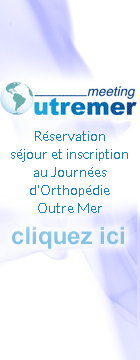Matheus Ribeiro Barcelos, Ricardo Berriel Mendes, Phd José
Calos Garcia Jr., Airthon Correia
(Sao Paulo, SP Brésil)
intervention. Numerous techniques have been documented, totaling over 100 when combined. Traditional treatments often result in soft tissue damage and scar formation, potentially compromising the deltoid muscle. Endoscopic approaches, while effective, require an extended learning curve and longer surgical times. This technical note aims to present a percutaneous approach assisted by intraoperative ultrasound, designed to reduce surgical time and minimize soft tissue damage, thereby providing an effective surgical solution.
Surgical Technique:
The patient is placed in the beach chair position with less inclination than inarthroscopy; we prefer a 30-degree inclination, ensuring the scapula is free. This is done under general anesthesia and plexus block. The ultrasound (Fujifilm Sonosite® ultrasound) is positioned on the side opposite the surgeon, using a high-frequency linear transducer. With a sterile Codman pen, we mark the anatomical points. We cover the ultrasound with a sterile plastic cover and use sterile ultrasound gel for visualization. We identify the structures and test the reduction of the AC joint, confirmed through ultrasound visualization. The first step is to identify the coracoid process. With the ultrasound transducer in a transverse position, we identify the top to the base of the coracoid. In this position, we rotate the transducer to a longitudinal position, with the lower end of the transducer visualizing the upper part of the coracoid and the upper end of the transducer visualizing the lower part of the clavicle. With a gentle maneuver, it is possible to identify the injury to the conoid and trapezoid ligaments. Using a sterile pen (Codman), we mark a point in the middle of the clavicle, exactly at the anchor entry point. A small incision is made with an 11-blade scalpel, approximately 1-2 cm in transverse length. After the incision, we use a Kelly clamp to create a path to the bone and remove soft tissue and deltoid fibers. We introduce the anchor guide and drill a hole with a 2.9 mm Juggerknot anchor drill (Zimmer®), traversing the cortices of the clavicle. The guide is then kept in the hole made in the clavicle, and using the same guide, we drill into the upper part of the coracoid, with ultrasound visualization. We insert the Juggerknot anchor (Zimmer®) and verify its position with ultrasound. The correct position of the anchor is between the anatomical insertions of the conoid and trapezoid ligaments on the superior surface of the coracoid bone, verified again with the linear transducer in longitudinal and transverse positions.
After ensuring the anchor is properly introduced into the upper region of the coracoid process, the anchor threads are passed through the 4.5 mm button hole (Zimmer®). The threads are held under tension by the assistant (Fig. 8). Using a Kelly clamp, the surgeon introduces the button, with the assistant maintaining tension on the threads, ensuring the button reaches the clavicle bone. Upon reaching the bone, compression is applied to the upper region of the clavicle, and the shoulder is pushed upwards through flexion of the elbow to reduce the AC joint. Reduction is confirmed with ultrasound, and the threads are tightened while the assistant maintains reduction. Reduction is checked again after tying the knot. After stabilizing the vertical direction, we need to stabilize the horizontal. Place the ultrasound in the acromioclavicular joint, and with a drill from posterior to anterior, use a Zip Tight fixation system (Zimmer®). Skin sutures and dressing are applied after the procedure. The patient is kept in a sling for 3 weeks postoperatively, with passive scapular exercises encouraged. Passive shoulder exercises are introduced in the third week, with elevation limited to 90 degrees, and the sling is worn only at night until the fifth week. Active shoulder exercises and full elevation above 90 degrees are initiated in the fifth week. Strengthening exercises and sport-specific activities are introduced after 3 months. The note concludes that a percutaneous approach using ultrasound enables effective treatment, less soft tissue damage, and faster procedure time.


